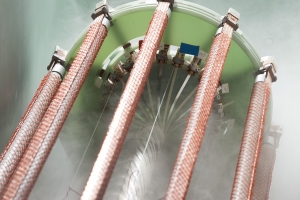180 days or 4300 hours – for this period, the AmpaCity superconducting cable in Essen has been conducting power so far. Today, on October 27, the project partners, inclusive of the Karlsruhe Institute of Technology, are taking positive stock. The superconductor transports five times more electricity than conventional copper cables with hardly any losses. Since its commissioning on April 30 this year, the cable of one kilometer in length has distributed about 20 million kilowatt hours, corresponding to the consumption of about 10,000 households in Essen.
“The AmpaCity project shows that it is possible in Germany to transfer fundamental research to application,” Mathias Noe, Head of the Institute of Technical Physics of KIT and project partner of AmpaCity, says. “Research contributes to solving societal challenges, such as the transformation of the energy system in Germany. For this purpose, application-oriented fundamental research financed from federal funds takes place in close cooperation with innovative industrial development.”
After 180 days of operation, the project partners now took a first positive stock. “So far, operation has taken place without any trouble. We have obtained valuable technical findings that helped us further optimize the superconductor system,” said Dr. Joachim Schneider, Chief Technical Officer of RWE Deutschland. The project partners modified the system monitoring scheme for an optimal integration of the superconductor into the protection system of the Essen power grid. In addition, the cooling cycle of the cable was adapted to the special requirements of AmpaCity.
The AmpaCity flagship project that has meanwhile gained worldwide recognition is financed from funds of the Federal Ministry for Economic Affairs and Energy (BMWi). “The Energiewende needs courageous innovations for an efficient and secure design of tomorrow’s energy system. That is why we deliberately selected this excellent project for funding under our energy research program,” said Uwe Beckmeyer, Parliamentary Undersecretary of State with the Federal Minister for Economic Affairs and Energy, during his visit in Essen. The BMWi funded the project with EUR 5.9 million. An investment of EUR 13.5 million was made by the project partners. These are RWE as the grid operator, the cable manufacturer Nexans, and Karlsruhe Institute of Technology (KIT) that scientifically supports the field tests.
Prior to the AmpaCity project, KIT coordinated a detailed study relating to the technical feasibility and economic efficiency of the use of superconductors on the intra-urban medium-voltage level. Superconducting cables are the most reasonable option to reduce high-voltage cables in urban grids, to simplify the grid structure, and to dismantle resource- and area-consuming transformer stations. Copper medium-voltage cables can transmit high powers in cities at comparably low costs, but Ohmic losses are high. The preliminary study highlights the advantages associated with the use of 10,000-volt superconductors in the intra-urban distribution grid and the dismantling of high-voltage facilities. In the medium term, this would result in an enhanced efficiency, a leaner grid, and reduced operation and maintenance costs with a smaller consumption of areas in the city.
High-temperature superconductivity and power transport at minus 200 instead of minus 270°C is based on research conducted by Professor Alex Müller and Dr. Johannes Georg Bednorz, who were granted the Physics Nobel Prize in 1987 for their work. Thanks to the properties of the superconducting material, a special ceramic, and its cooling to minus 200°C, the cable is turned into an ideal electric conductor. In Essen, the 10,000-volt superconducting cable replaces a conventional 110,000-volt line.
The technical findings obtained from the project meet with wide interest in Germany and abroad. Delegations from France, Ghana, the USA, China, and Japan have already come to Essen to be given first-hand explanations of the technology.
In close partnership with society, KIT develops solutions for urgent challenges – from climate change, energy transition and sustainable use of natural resources to artificial intelligence, sovereignty and an aging population. As The University in the Helmholtz Association, KIT unites scientific excellence from insight to application-driven research under one roof – and is thus in a unique position to drive this transformation. As a University of Excellence, KIT offers its more than 10,000 employees and 22,800 students outstanding opportunities to shape a sustainable and resilient future. KIT – Science for Impact.

